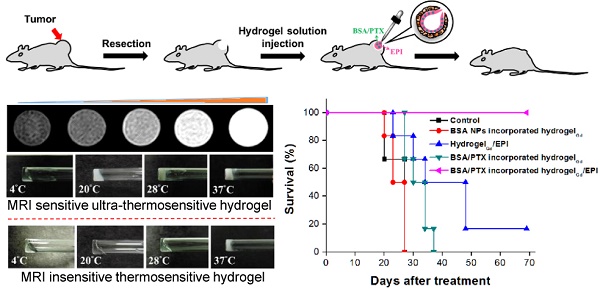当前位置:
X-MOL 学术
›
Theranostics
›
论文详情
Our official English website, www.x-mol.net, welcomes your feedback! (Note: you will need to create a separate account there.)
Fabrication of Tissue-Engineered Bionic Urethra Using Cell Sheet Technology and Labeling By Ultrasmall Superparamagnetic Iron Oxide for Full-Thickness Urethral Reconstruction
Theranostics ( IF 12.4 ) Pub Date : 2017-06-25 , DOI: 10.7150/thno.18833 Shukui Zhou , Ranxin Yang , Qingsong Zou , Kaile Zhang , Ting Yin , Weixin Zhao , Joseph G. Shapter , Guo Gao , Qiang Fu
Theranostics ( IF 12.4 ) Pub Date : 2017-06-25 , DOI: 10.7150/thno.18833 Shukui Zhou , Ranxin Yang , Qingsong Zou , Kaile Zhang , Ting Yin , Weixin Zhao , Joseph G. Shapter , Guo Gao , Qiang Fu

|
Urethral strictures remain a reconstructive challenge, due to less than satisfactory outcomes and high incidence of stricture recurrence. An “ideal” urethral reconstruction should establish similar architecture and function as the original urethral wall. We fabricated a novel tissue-engineered bionic urethras using cell sheet technology and report their viability in a canine model. Small amounts of oral and adipose tissues were harvested, and adipose-derived stem cells, oral mucosal epithelial cells, and oral mucosal fibroblasts were isolated and used to prepare cell sheets. The cell sheets were hierarchically tubularized to form 3-layer tissue-engineered urethras and labeled by ultrasmall super-paramagnetic iron oxide (USPIO). The constructed tissue-engineered urethras were transplanted subcutaneously for 3 weeks to promote the revascularization and biomechanical strength of the implant. Then, 2 cm length of the tubularized penile urethra was replaced by tissue-engineered bionic urethra. At 3 months of urethral replacement, USPIO-labeled tissue-engineered bionic urethra can be effectively detected by MRI at the transplant site. Histologically, the retrieved bionic urethras still displayed 3 layers, including an epithelial layer, a fibrous layer, and a myoblast layer. Three weeks after subcutaneous transplantation, immunofluorescence analysis showed the density of blood vessels in bionic urethra was significantly increased following the initial establishment of the constructs and was further up-regulated at 3 months after urethral replacement and was close to normal level in urethral tissue. Our study is the first to experimentally demonstrate 3-layer tissue-engineered urethras can be established using cell sheet technology and can promote the regeneration of structural and functional urethras similar to normal urethra.
中文翻译:

利用细胞片技术制造组织工程仿生尿道并通过超小型超顺磁性氧化铁标记进行全层尿道重建
尿道狭窄仍然是一项重建性的挑战,因为结局效果不理想且狭窄复发的发生率很高。“理想的”尿道重建应建立与原始尿道壁相似的结构和功能。我们使用细胞片技术制造了一种新型的组织工程化仿生尿道,并在犬模型中报告了它们的生存能力。收集少量的口腔和脂肪组织,并分离脂肪来源的干细胞,口腔粘膜上皮细胞和口腔粘膜成纤维细胞,并将其用于制备细胞片。将细胞片分层管状化以形成3层组织工程尿道,并用超小型超顺磁性氧化铁(USPIO)标记。将构建的组织工程化尿道皮下移植3周,以促进植入物的血运重建和生物力学强度。然后,将2 cm长的管状化阴茎尿道替换为组织工程仿生尿道。更换尿道3个月后,可以在移植部位通过MRI有效检测USPIO标记的组织工程化仿生尿道。从组织学上讲,取回的仿生尿道仍显示3层,包括上皮层,纤维层和成肌细胞层。皮下移植三周后,免疫荧光分析表明,在最初构建构建体后,仿生尿道中的血管密度显着增加,并且在尿道更换后3个月进一步上调,并且在尿道组织中接近正常水平。我们的研究首次通过实验证明,可以使用细胞片技术建立3层组织工程化尿道,并且可以促进类似于正常尿道的结构和功能性尿道的再生。
更新日期:2017-09-04
中文翻译:

利用细胞片技术制造组织工程仿生尿道并通过超小型超顺磁性氧化铁标记进行全层尿道重建
尿道狭窄仍然是一项重建性的挑战,因为结局效果不理想且狭窄复发的发生率很高。“理想的”尿道重建应建立与原始尿道壁相似的结构和功能。我们使用细胞片技术制造了一种新型的组织工程化仿生尿道,并在犬模型中报告了它们的生存能力。收集少量的口腔和脂肪组织,并分离脂肪来源的干细胞,口腔粘膜上皮细胞和口腔粘膜成纤维细胞,并将其用于制备细胞片。将细胞片分层管状化以形成3层组织工程尿道,并用超小型超顺磁性氧化铁(USPIO)标记。将构建的组织工程化尿道皮下移植3周,以促进植入物的血运重建和生物力学强度。然后,将2 cm长的管状化阴茎尿道替换为组织工程仿生尿道。更换尿道3个月后,可以在移植部位通过MRI有效检测USPIO标记的组织工程化仿生尿道。从组织学上讲,取回的仿生尿道仍显示3层,包括上皮层,纤维层和成肌细胞层。皮下移植三周后,免疫荧光分析表明,在最初构建构建体后,仿生尿道中的血管密度显着增加,并且在尿道更换后3个月进一步上调,并且在尿道组织中接近正常水平。我们的研究首次通过实验证明,可以使用细胞片技术建立3层组织工程化尿道,并且可以促进类似于正常尿道的结构和功能性尿道的再生。


























 京公网安备 11010802027423号
京公网安备 11010802027423号